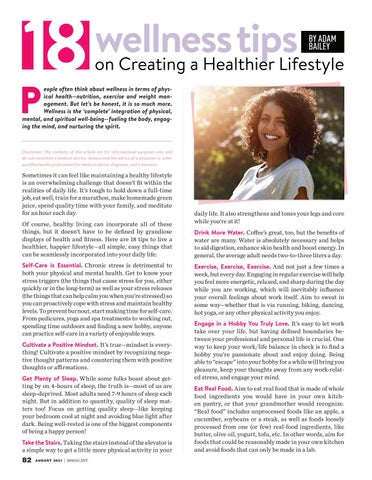18
P
wellness tips on Creating a Healthier Lifestyle BY ADAM BAILEY
eople often think about wellness in terms of physical health—nutrition, exercise and weight management. But let’s be honest, it is so much more. Wellness is the ‘complete’ integration of physical, mental, and spiritual well-being—fueling the body, engaging the mind, and nurturing the spirit.
Disclaimer: The contents of this article are for informational purposes only and do not constitute a medical service. Always seek the advice of a physician or other qualified health professional for medical advice, diagnosis, and treatment.
Sometimes it can feel like maintaining a healthy lifestyle is an overwhelming challenge that doesn’t fit within the realities of daily life. It’s tough to hold down a full-time job, eat well, train for a marathon, make homemade green juice, spend quality time with your family, and meditate for an hour each day. Of course, healthy living can incorporate all of these things, but it doesn’t have to be defined by grandiose displays of health and fitness. Here are 18 tips to live a healthier, happier lifestyle—all simple, easy things that can be seamlessly incorporated into your daily life: Self-Care is Essential. Chronic stress is detrimental to both your physical and mental health. Get to know your stress triggers (the things that cause stress for you, either quickly or in the long-term) as well as your stress releases (the things that can help calm you when you’re stressed) so you can proactively cope with stress and maintain healthy levels. To prevent burnout, start making time for self-care. From pedicures, yoga and spa treatments to working out, spending time outdoors and finding a new hobby, anyone can practice self-care in a variety of enjoyable ways. Cultivate a Positive Mindset. It’s true—mindset is everything! Cultivate a positive mindset by recognizing negative thought patterns and countering them with positive thoughts or affirmations. Get Plenty of Sleep. While some folks boast about getting by on 4-hours of sleep, the truth is—most of us are sleep-deprived. Most adults need 7-9 hours of sleep each night. But in addition to quantity, quality of sleep matters too! Focus on getting quality sleep—like keeping your bedroom cool at night and avoiding blue light after dark. Being well-rested is one of the biggest components of being a happy person! Take the Stairs. Taking the stairs instead of the elevator is a simple way to get a little more physical activity in your
82
AUGUST 2021
| SBMAG.NET
daily life. It also strengthens and tones your legs and core while you’re at it! Drink More Water. Coffee’s great, too, but the benefits of water are many. Water is absolutely necessary and helps to aid digestion, enhance skin health and boost energy. In general, the average adult needs two-to-three liters a day. Exercise, Exercise, Exercise. And not just a few times a week, but every day. Engaging in regular exercise will help you feel more energetic, relaxed, and sharp during the day while you are working, which will inevitably influence your overall feelings about work itself. Aim to sweat in some way—whether that is via running, biking, dancing, hot yoga, or any other physical activity you enjoy. Engage in a Hobby You Truly Love. It’s easy to let work take over your life, but having defined boundaries between your professional and personal life is crucial. One way to keep your work/life balance in check is to find a hobby you’re passionate about and enjoy doing. Being able to “escape” into your hobby for a while will bring you pleasure, keep your thoughts away from any work-related stress, and engage your mind. Eat Real Food. Aim to eat real food that is made of whole food ingredients you would have in your own kitchen pantry, or that your grandmother would recognize. “Real food” includes unprocessed foods like an apple, a cucumber, soybeans or a steak, as well as foods loosely processed from one (or few) real-food ingredients, like butter, olive oil, yogurt, tofu, etc. In other words, aim for foods that could be reasonably made in your own kitchen and avoid foods that can only be made in a lab.













